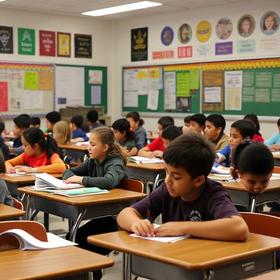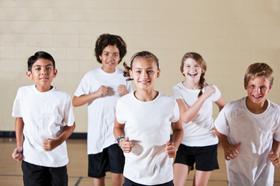Serving 55 students in grades 9-12, Dearborn Heights Virtual Academy ranks in the top 30% of all schools in Michigan for overall test scores (math proficiency is top 30%, and reading proficiency is top 30%).
The percentage of students achieving proficiency in math is <50% (which is higher than the Michigan state average of 35%). The percentage of students achieving proficiency in reading/language arts is <50% (which is higher than the Michigan state average of 43%).
Minority enrollment is 33% of the student body (majority Black), which is lower than the Michigan state average of 37% (majority Black).
Quick Facts (2025-26)
- School Type: Online School/Alternative school
- Grades: 9-12
- Enrollment: 55 students
- State Accredited: No
- Live Instruction: No
- Rolling Enrollment: No
- Minority Enrollment: 33%
- Graduation Rate: 21-39% (Btm 50% in MI)
- Math Proficiency: <50% (Top 20%)
- Reading Proficiency: <50%
- Source: National Center for Education Statistics (NCES), MI Dept. of Education
Top Rankings
Dearborn Heights Virtual Academy ranks among the top 20% of public schools in Michigan for:
Category
Attribute
Math Proficiency
Community Size
Student Attention
School Overview
Dearborn Heights Virtual Academy's student population of 55 students has grown by 189% over five school years.
The teacher population of 1 teachers has stayed relatively flat over five school years.
School Type
Grades Offered
Grades 9-12
(Exclusively virtual)
(Exclusively virtual)
Total Students
55 students
Gender %
Total Classroom Teachers
1 teacher
State Accredited Program
No
Personalized Content
No
Live Instruction
No
Rolling Enrollment
No
Flexible Class Schedule
No
Accelerated Offerings
No
Classes for Credit/Part Time Options
No
Dedicated College Counselor
No
Tutoring/Mentoring
No
Community Clubs/Activities Offered
No
School Calendar
School Motto
Unleash Your Potential
School Rankings
The diversity score of Dearborn Heights Virtual Academy is 0.50, which is less than the diversity score at state average of 0.56. The school's diversity has stayed relatively flat over five school years.
Math Test Scores (% Proficient)
<50%
35%
Reading/Language Arts Test Scores (% Proficient)
(17-18)<50%
43%
Student-Teacher Ratio
n/a
17:1
American Indian
n/a
1%
Asian
n/a
4%
Hispanic
13%
9%
Black
20%
18%
White
67%
63%
Hawaiian
n/a
n/a
Two or more races
n/a
5%
All Ethnic Groups
Graduation Rate
21-39%
81%
Participates in the National School Lunch Program (NSLP)
Yes
Eligible for Free Lunch
76%
50%
Eligible for Reduced Lunch
4%
4%
School Statewide Testing
School District Name
Source: National Center for Education Statistics (NCES), MI Dept. of Education
Profile last updated: 02/09/2025
Frequently Asked Questions
What schools are Dearborn Heights Virtual Academy often compared to?
Dearborn Heights Virtual Academyis often viewed alongside schools like Gull Lake Gateway Academy by visitors of our site.
What percent of students have achieved state testing proficiency in math and reading?
<50% of students have achieved math proficiency (compared to the 35% MI state average), while <50% of students have achieved reading proficiency (compared to the 43% MI state average).
What is the graduation rate of Dearborn Heights Virtual Academy?
The graduation rate of Dearborn Heights Virtual Academy is 21-39%, which is lower than the Michigan state average of 81%.
How many students attend Dearborn Heights Virtual Academy?
55 students attend Dearborn Heights Virtual Academy.
What is the racial composition of the student body?
67% of Dearborn Heights Virtual Academy students are White, 20% of students are Black, and 13% of students are Hispanic.
What grades does Dearborn Heights Virtual Academy offer ?
Dearborn Heights Virtual Academy offers enrollment in grades 9-12 (Exclusively virtual).
What school district is Dearborn Heights Virtual Academy part of?
Dearborn Heights Virtual Academy is part of Dearborn Heights School District #7.
School Reviews
Review Dearborn Heights Virtual Academy. Reviews should be a few sentences in length. Please include any comments on:
- Quality of academic programs, teachers, and facilities
- Availability of music, art, sports and other extracurricular activities
Recent Articles

How Public Schools Support Students on Free / Reduced-Lunch Programs
Explore how U.S. public schools support students eligible for free or reduced-price lunch through nutrition, academic, and wraparound services in 2025.

Hidden Costs of Public Schools: Fees, Supplies & Extras
Explore the hidden costs in public schools—fees, supplies, extracurriculars—and how parents can plan for them in 2025.

Public School Funding 2025: What Families Should Know
Essential insights on public school funding in 2025—how it works, what’s changing, and what families should know to stay ahead.





